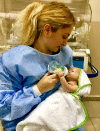An alternative supplemental feeding method for preterm infants: the supplemental feeding tube device
- PMID: 33992038
- PMCID: PMC8573934
- DOI: 10.3906/sag-2009-323
An alternative supplemental feeding method for preterm infants: the supplemental feeding tube device
Abstract
Background/aim: The purpose of this study was to determine the effects of the supplemental feeding tube device (SFTD) and bottle methods on weight gain, transition to full breastfeeding, breastfeeding success, and duration of discharge in preterm infants.
Materials and methods: This randomized controlled trial was conducted with a total of 46 preterm infants including 23 infants in study (SFTD) and control (bottle) groups. An information form, an infant follow-up form for feeding, and LATCH breastfeeding assessment instrument were used to collect the data.
Results: The gestation week of the infants in the study group was 31.22 ± 2.76, and in the control group it was 30.52 ± 2.47. The birth weight of the infants in the study group was 1586.3 ± 525.35 g and 1506.09 ± 454.77 g in the control group. The daily weight gain of the infants was 24.09 ± 15.21 g in the study group and 27.17 ± 17.63 g in the control group. The infants in the study group (4.70 ± 2.44 days) transitioned to full breastfeeding earlier than those in the control group (6.00 ± 4.10 days). LATCH 2nd measurement scores were significantly higher in both groups than LATCH 1st measurement scores (p < 0.01). Although it was not statistically significant (p > 0.05), the infants in the study group (10.22 ± 5.20 days) were discharged earlier than those in the control group (13.48 ± 8.78 days).
Conclusion: The SFTD and bottle methods were determined to be similar in terms of daily weight gain, transition to full breastfeeding, breastfeeding success, and duration of hospitalization.
Keywords: Bottle feeding; breastfeeding; neonatal intensive care unit; premature; supplemental feeding methods.
This work is licensed under a Creative Commons Attribution 4.0 International License.
Conflict of interest statement
The authors declared no potential conflicts of interest with respect to the research, authorship, and/or publication of this article.
Figures
Similar articles
-
The Effect of Supplemental Feeding Tube Device on Time to Transition to Exclusive Breastfeeding and Discharge: A Randomized Controlled Trial with Preterm Infants.Breastfeed Med. 2024 Sep;19(9):707-714. doi: 10.1089/bfm.2024.0084. Epub 2024 Jun 21. Breastfeed Med. 2024. PMID: 38904090 Clinical Trial.
-
The effect of feeding methods of bottle and injector on the transition to full breastfeeding and sucking success in preterm newborns: A randomized controlled trial.J Pediatr Nurs. 2022 Nov-Dec;67:e65-e70. doi: 10.1016/j.pedn.2022.09.016. Epub 2022 Nov 3. J Pediatr Nurs. 2022. PMID: 36336532 Clinical Trial.
-
Comparison of Effect of Feeding Premature Infants with Either Cup, Bottle, and Syringe on Transition to Breastfeeding, Breastfeeding Success, Weight Gain, and Duration of Hospitalization.Breastfeed Med. 2023 Aug;18(8):586-595. doi: 10.1089/bfm.2023.0069. Breastfeed Med. 2023. PMID: 37615568 Clinical Trial.
-
Cup Feeding as a Supplemental, Alternative Feeding Method for Preterm Breastfed Infants: An Integrative Review.Matern Child Health J. 2018 Nov;22(11):1568-1579. doi: 10.1007/s10995-018-2632-9. Matern Child Health J. 2018. PMID: 30328044 Review.
-
Nutrition, growth, and allergic diseases among very preterm infants after hospital discharge.Dan Med J. 2013 Feb;60(2):B4588. Dan Med J. 2013. PMID: 23461996 Review.
Cited by
-
Avoidance of bottles during the establishment of breastfeeds in preterm infants.Cochrane Database Syst Rev. 2021 Oct 21;10(10):CD005252. doi: 10.1002/14651858.CD005252.pub5. Cochrane Database Syst Rev. 2021. PMID: 34671969 Free PMC article.
-
Effectiveness of Interventions to Manage Difficulties with Breastfeeding for Mothers of Infants under Six Months with Growth Faltering: A Systematic Review Update.Nutrients. 2023 Feb 16;15(4):988. doi: 10.3390/nu15040988. Nutrients. 2023. PMID: 36839345 Free PMC article.
References
-
- Lau C Oral feeding in the preterm infant. NeoReviews. 2006;7:19–27.
-
- Penny F Judge M Brownell EA McGrath JM International board certified lactation consultants’ practices regarding supplemental feeding methods for breastfed infants. Journal of Human Lactation. 2019;35:683–694. - PubMed
-
- Penny F Judge M Brownell E McGrath JM Gephart S What is the evidence for use of a supplemental feeding tube device as an alternative supplemental feeding method for breastfed infants. Advances in Neonatal Care. 2018;18:31–37. - PubMed
-
- Özsoy S Aksu H Ten steps to successful breastfeeding: violation reasons and results of steps 6 and 9. Turkiye Klinikleri Journal of Nursing Sciences. 2019;11:74–80.
Publication types
MeSH terms
LinkOut - more resources
Full Text Sources
Other Literature Sources
Medical




